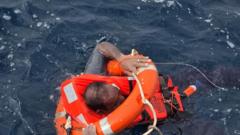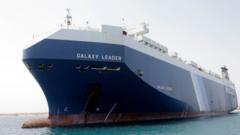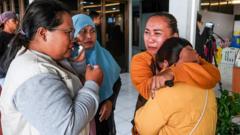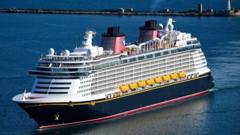Amidst the chaos of the Sea Story’s sinking, survivors recount their desperate struggle for survival and the systemic safety issues that may have contributed to the disaster. What transpired during the night of November 25, 2022, raises serious concerns about maritime safety in the Red Sea.
**Survivors Recall Harrowing 35-Hour Ordeal After Red Sea Boat Capsizes**

**Survivors Recall Harrowing 35-Hour Ordeal After Red Sea Boat Capsizes**
Survivors of the tragic sinking of the Sea Story dive boat share their thoughts on the event, highlighting lapses in safety and urgent questions surrounding the rescue efforts.
---
Lucianna Galetta's voice quivers as she recalls the terror of spending 35 hours trapped in a pitch-black air pocket following the sinking of the Sea Story, a dive boat that met its fate in the Red Sea. Trapped alongside her partner and a dive instructor, they thought their lives might end in the submerged wreck that left them in near darkness. Lucianna’s ordeal was far from unique; it echoed the experiences of 34 other survivors, some of whom were not so fortunate. Up to 11 individuals, including two Britons, are either dead or missing presumed dead.
The vessel sank after setting off from Egypt’s Port Ghaleb, reportedly due to a massive wave—a claim survivors dispute. Eleven survivors provided testimony suggesting that crew error and design flaws likely contributed to the tragedy, supported by meteorological data which contradicts the idea of a 4-meter wave affecting the vessel that evening. Critically, the survivors articulated serious safety failings they believe were exacerbated by the slow response of Egyptian authorities, a delay that could have cost lives.
Onboard the Sea Story were 31 international guests and 12 crew members, participating in what was supposed to be a gratifying diving adventure. Initial impressions of the seemingly spacious and clean vessel quickly turned precarious as unusual rocking of the boat heralded impending doom. In the moments leading to the capsizing, conditions felt manageable; however, several guests reflected on moments of unshakeable dread as furniture began to slide on the decks, an ominous prelude to the boat’s eventual roll.
As the boat rolled over, chaos ensued, with darkness enveloping the interior. Survivors were left disoriented; paths of escape were littered with debris from the disturbed cabins. Hissora Gonzalez, another survivor, described the frightening disarray as people grappled to find life jackets while trying to flee. In stark contrast, a small group successfully made it to the top deck amidst the mounting panic, aware that jumping into the water presented its own set of dangers. The rising tide of despair worsened as some passengers struggled to navigate unsecured furniture that had shifted dangerously while maintaining their footing.
Days later, recollections of attempts to rescue others were recounted, explaining the lack of functional safety equipment on the life rafts—despite expectations of emergency supplies. As rescuers approached, the long wait was fraught with uncertainty and fear. Lucianna and her partner were eventually extracted along with a few other survivors, but the near-24-hour ordeal in the wreck left deep emotional scars.
The tragic story is compounded by the mystery surrounding the still-missing couple, Jenny Cawson and Tarig Sinada. Their friends lament the pain of uncertainty, tying their absence to an unanticipated shift just prior to departure. Survivors urge for accountability; questions linger about the lack of an immediate distress signal and the untethered furniture that may have adversely affected the vessel’s stability.
As discussions of the incident continue, the reluctance of the officials to acknowledge potential failures infuriates those seeking answers. The overarching message remains clear: the survivors want to ensure that the echoes of their voices lead to a safer future for divers in the region—reminding everyone that safety must never take a backseat to adventure.
Lucianna Galetta's voice quivers as she recalls the terror of spending 35 hours trapped in a pitch-black air pocket following the sinking of the Sea Story, a dive boat that met its fate in the Red Sea. Trapped alongside her partner and a dive instructor, they thought their lives might end in the submerged wreck that left them in near darkness. Lucianna’s ordeal was far from unique; it echoed the experiences of 34 other survivors, some of whom were not so fortunate. Up to 11 individuals, including two Britons, are either dead or missing presumed dead.
The vessel sank after setting off from Egypt’s Port Ghaleb, reportedly due to a massive wave—a claim survivors dispute. Eleven survivors provided testimony suggesting that crew error and design flaws likely contributed to the tragedy, supported by meteorological data which contradicts the idea of a 4-meter wave affecting the vessel that evening. Critically, the survivors articulated serious safety failings they believe were exacerbated by the slow response of Egyptian authorities, a delay that could have cost lives.
Onboard the Sea Story were 31 international guests and 12 crew members, participating in what was supposed to be a gratifying diving adventure. Initial impressions of the seemingly spacious and clean vessel quickly turned precarious as unusual rocking of the boat heralded impending doom. In the moments leading to the capsizing, conditions felt manageable; however, several guests reflected on moments of unshakeable dread as furniture began to slide on the decks, an ominous prelude to the boat’s eventual roll.
As the boat rolled over, chaos ensued, with darkness enveloping the interior. Survivors were left disoriented; paths of escape were littered with debris from the disturbed cabins. Hissora Gonzalez, another survivor, described the frightening disarray as people grappled to find life jackets while trying to flee. In stark contrast, a small group successfully made it to the top deck amidst the mounting panic, aware that jumping into the water presented its own set of dangers. The rising tide of despair worsened as some passengers struggled to navigate unsecured furniture that had shifted dangerously while maintaining their footing.
Days later, recollections of attempts to rescue others were recounted, explaining the lack of functional safety equipment on the life rafts—despite expectations of emergency supplies. As rescuers approached, the long wait was fraught with uncertainty and fear. Lucianna and her partner were eventually extracted along with a few other survivors, but the near-24-hour ordeal in the wreck left deep emotional scars.
The tragic story is compounded by the mystery surrounding the still-missing couple, Jenny Cawson and Tarig Sinada. Their friends lament the pain of uncertainty, tying their absence to an unanticipated shift just prior to departure. Survivors urge for accountability; questions linger about the lack of an immediate distress signal and the untethered furniture that may have adversely affected the vessel’s stability.
As discussions of the incident continue, the reluctance of the officials to acknowledge potential failures infuriates those seeking answers. The overarching message remains clear: the survivors want to ensure that the echoes of their voices lead to a safer future for divers in the region—reminding everyone that safety must never take a backseat to adventure.





















